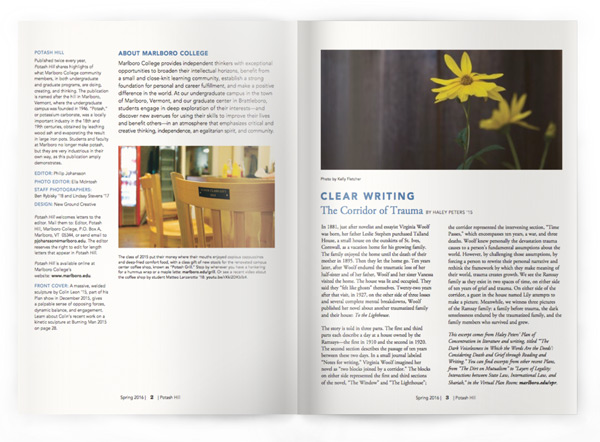Clear Writing

The Corridor of Trauma
By Haley Peters ’15
In 1881, just after novelist and essayist Virginia Woolf was born, her father Leslie Stephen purchased Talland House, a small house on the outskirts of St. Ives, Cornwall, as a vacation home for his growing family. The family enjoyed the home until the death of their mother in 1895. Then they let the home go. Ten years later, after Woolf endured the traumatic loss of her half-sister and of her father, Woolf and her sister Vanessa visited the home. The house was lit and occupied. They said they “felt like ghosts” themselves. Twenty-two years after that visit, in 1927, on the other side of three losses and several complete mental breakdowns, Woolf published her novel about another traumatized family and their house: To the Lighthouse.
The story is told in three parts. The first and third parts each describe a day at a house owned by the Ramsays—the first in 1910 and the second in 1920. The second section describes the passage of ten years between these two days. In a small journal labeled “Notes for writing,” Virginia Woolf imagined her novel as “two blocks joined by a corridor.” The blocks on either side represented the first and third sections of the novel, “The Window” and “The Lighthouse”; the corridor represented the intervening section, “Time Passes,” which encompasses ten years, a war, and three deaths. Woolf knew personally the devastation trauma causes to a person’s fundamental assumptions about the world. However, by challenging those assumptions, by forcing a person to rewrite their personal narrative and rethink the framework by which they make meaning of their world, trauma creates growth. We see the Ramsay family as they exist in two spaces of time, on either side of ten years of grief and trauma. On either side of the corridor, a guest in the house named Lily attempts to make a picture. Meanwhile, we witness three pictures of the Ramsay family: a family before trauma, the dark senselessness endured by the traumatized family, and the family members who survived and grew.
This excerpt comes from Haley Peters’ Plan of Concentration in literature and writing, titled “‘The Dark Voicelessness in Which the Words Are the Deeds’: Considering Death and Grief through Reading and Writing.” You can find excerpts from other recent Plans, from “The Dirt on Mutualism” to “Layers of Legality: Interactions between State Law, International Law, and Shariah,” in the Virtual Plan Room. Photo by Kelly Fletcher